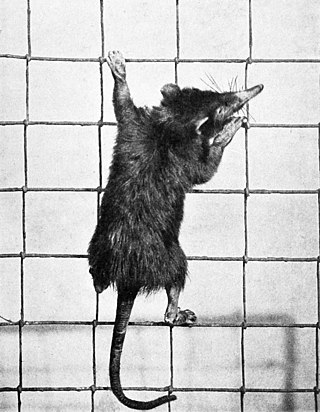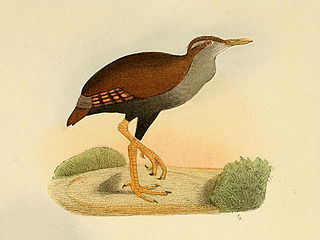
Rails are a large, cosmopolitan family of small- to medium-sized terrestrial and/or semi-amphibious birds. The family exhibits considerable diversity in its forms, and includes such ubiquitous species as the crakes, coots, and gallinule; other rail species are extremely rare or endangered. Many are associated with wetland habitats, some being semi-aquatic like waterfowl, but many more are wading birds or shorebirds. The ideal rail habitats are marsh areas, including rice paddies, and flooded fields or open forest. They are especially fond of dense vegetation for nesting. The rail family is found in every terrestrial habitat with the exception of dry desert, polar or freezing regions, and alpine areas. Members of Rallidae occur on every continent except Antarctica. Numerous unique island species are known.

The common moorhen, also known as the waterhen or swamp chicken, is a bird species in the rail family (Rallidae). It is distributed across many parts of the Old World.

The common gallinule is a bird in the family Rallidae. It was split from the common moorhen by the American Ornithologists' Union in July 2011. It lives around well-vegetated marshes, ponds, canals, and other wetlands in the Americas. The common gallinule is one of the most conspicuous rail species in North America, along with the American coot.

The Cuban solenodon or almiquí is a small, furry, shrew-like mammal endemic to mountainous forests on Cuba. It is the only species in the genus Atopogale. An elusive animal, it lives in burrows and is only active at night when it uses its unusual toxic saliva to feed on insects. The solenodons, native to the Caribbean, are one of only a few mammals that are venomous.

Moorhens—sometimes called marsh hens—are medium-sized water birds that are members of the rail family (Rallidae). Most species are placed in the genus Gallinula, Latin for "little hen". They are close relatives of coots. They are often referred to as (black) gallinules. Recently, one of the species of Gallinula was found to have enough differences to form a new genus Paragallinula with the only species being the lesser moorhen.

The bushwren, also known as the mātuhituhi in the Māori language, was a very small and almost flightless bird that was endemic to New Zealand. It had three subspecies on each of the major islands of New Zealand, the North Island, South Island, and Stewart Island / Rakiura and nearby smaller islands. The species disappeared gradually after the introduction of invasive mammalian predators, last being seen on the North Island in 1955 and the South Island in 1968. Attempts were made to save the remaining population on small islands off Stewart Island, but they ultimately failed with the death of the last remaining known birds in 1972.

The South Island piopio also known as the New Zealand thrush, was a passerine bird of the family Oriolidae.
Barawertornis tedfordi was a dromornithid (mihirung), a large flightless fowl hailing from Late Oligocene to Early Miocene. The only species in the genus Barawertornis, its fossil remains are found in strata of the Riversleigh deposits located at two sites in Northwestern Queensland, Australia.

Porphyrio is the swamphen or swamp hen bird genus in the rail family. It includes some smaller species of gallinules which are sometimes separated as genus Porphyrula or united with the gallinules proper in Gallinula. The Porphyrio gallinules are distributed in the warmer regions of the world. The group probably originated in Africa in the Middle Miocene, before spreading across the world in waves from the Late Miocene to Pleistocene.

The Norfolk kākā is an extinct species of large parrot, belonging to the parrot family Nestoridae. The birds were about 38 cm long, with mostly olive-brown upperparts, reddish-orange cheeks and throat, straw-coloured breast, thighs, rump and lower abdomen dark orange and a prominent beak. It inhabited the rocks and treetops of Norfolk Island and adjacent Phillip Island. It was a relative of the New Zealand kākā.

The Tahiti rail, Tahitian red-billed rail, or Pacific red-billed rail is an extinct species of rail that lived on Tahiti. It was first recorded during James Cook's second voyage around the world (1772–1775), on which it was illustrated by Georg Forster and described by Johann Reinhold Forster. No specimens have been preserved. As well as the documentation by the Forsters, there have been claims that the bird also existed on the nearby island of Mehetia. The Tahiti rail appears to have been closely related to, and perhaps derived from, the buff-banded rail, and has also been historically confused with the Tongan subspecies of that bird.

The Hawaiian rail, Hawaiian spotted rail, or Hawaiian crake is an extinct species of diminutive rail that lived on Big Island of Hawaiʻi.

The tooth-billed pigeon, also known as the manumea, is a large pigeon found only in Samoa. It is the only living species of genus Didunculus. A related extinct species, the Tongan tooth-billed pigeon, is only known from subfossil remains in several archeological sites in Tonga. The tooth-billed pigeon is the national bird of Samoa and featured on the 20 tālā bills and the 50 sene pieces of the 2008/2011 series. Native only to Samoa's primary rainforest, it is considered to be endangered, with only a few hundred individuals thought to remain in existence.
The Tasman starling was described in 1836 by John Gould as a species which occurred on both Norfolk Island and Lord Howe Island. In 1928 Australian ornithologist Gregory Mathews recognized that the plumage of the race from Lord Howe Island was much browner and more greyish than the plumage of the Norfolk Island race and split the species into two forms, the Norfolk starling, and the Lord Howe starling. Both subspecies are now extinct, thus so the species.

The bar-winged rail is an extinct species of bird in the family Rallidae. It was endemic to Fiji and was last collected ca 1890 in Viti Levu. The species was identified from twelve 19th century specimens, some of which are known to be in Boston, London and New York. The last unconfirmed sighting of this bird was in 1973.
Hodgens' waterhen is an extinct rail species from New Zealand. Its name commemorates the Hodgen brothers who were owners of the Pyramid Valley swamp where the holotype was discovered. It reached a weight of 280 g and its wings were so reduced that it was unable to fly. It occupied a wide range of habitats, including open forest and grassland along riverbanks.

The Samoan tropical moist forests are a tropical moist broadleaf forest ecoregion in the Samoan Islands of the Pacific Ocean.

The Hawaiian gallinule is an endangered chicken-sized water bird in the rail family. It is also variously known as the Hawaiian common gallinule, Hawaiian moorhen, Hawaiian common moorhen, mudhen, or ‘alae ‘ula in Hawaiian, and sometimes misleadingly as the Hawaiian red coot. It is a subspecies of the common gallinule that is endemic to the tropical Hawaiian Islands of the north-central Pacific Ocean.
















